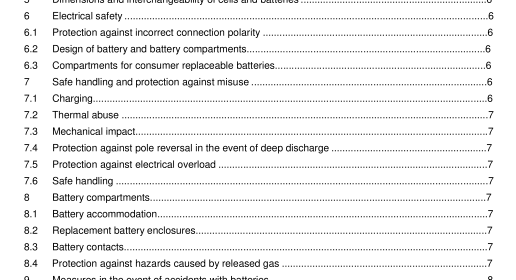BS EN 50272-4:2007 – Safety requirements for secondary batteries and battery installations — Part 4: Batteries for use in portable appliances

7.2 Thermal abuse Battery systems for portable appliances shall not be overheated. Overheating due to service conditions will destroy the battery and, in individual cases, the equipment as well. Depending on the type of battery corrosive and/or toxic liquids or gases may be released. Therefore batteries shall be inserted into the appliances in such a way that their permissible temperature range is not exceeded.
7.3 Mechanical impact Batteries shall be protected from mechanical damage which may cause leakage of hazardous chemicals causing short-circuits which may result in overheating and subsequent rupturing of further cells.
7.4 Protection against pole reversal in the event of deep discharge Secondary batteries shall be charged / discharged, so that each cell gets charged or discharged to the same extent (taps in the battery string lead to uneven discharge condition). Only cells and/or batteries of the same type and age shall be connected in series. The maximum number of cells specified by the battery manufacturer and any required protective measure for series connection shall be observed in order to avoid pole reversal of individual cells in the event of deep discharge of the battery bank. Depending on the battery system reverse polarity can destroy the battery, damage the appliance, and expose the user to danger e.g. due to battery leakage. A low voltage protection dev
ice may be provided for disconnection of the equipment from the load. If some cell reversal may cause damage to equipment or persons a protective device is required. 7.5 Protection against electrical overload Appliances and batteries shall be protected by short-circuit and overload protection devices, if the available battery power may cause damage to equipment or persons.
7.6 Safe handling To achieve safe handling during transport, installation and replacement the battery terminals and the connection cables shall be designed so that short circuits are not possible.
8 Battery compartments Secondary batteries in portable appliances can be of permanently fixed installation, can be replaceable for recharging separately outside of the appliance or can be replaceable by primary batteries. In case of replaceable batteries the requirements
8.1 to 8.4 apply. Where watertight equipment is used safety precautions are required to prevent or limit the generation of hydrogen.
8.1 Battery accommodation Battery enclosures for accommodation of batteries in electrical equipment shall be designed, where necessary, to be separate from the functional parts of the equipment and accessible from the outside. NOTE Cells or batteries may leak electrolyte. Both valve-regulated and gas-tight secondary batteries have a safety device (valve or vent) which release gas when activated.
BS EN 50272-4:2007 – Safety requirements for secondary batteries and battery installations — Part 4: Batteries for use in portable appliances